Weekly Fishing Report: October 11
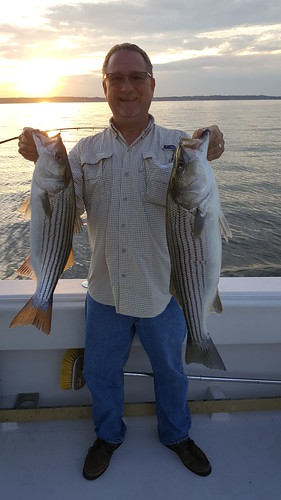
Jim Byrd caught these two nice striped bass while trolling spoons and Tsunamis off Deale recently. Photo courtesy of Jim Byrd
Recent warm weather has caused Chesapeake Bay and tidal river water temperatures to be rather stagnant this week. Water temperatures in all three regions of the bay are holding around 73 degrees to 75 degrees and the tidal rivers are running about 3-5 degrees cooler. It is going to take a prolonged cool front to drive water temperatures down to the upper 60s, which will then cause baitfish to move out of the tidal rivers and into the bay. Striped bass will be waiting for them and hopefully the fall fishery for Maryland’s state fish will finally kick into gear.
Vertical jigging in the upper bay region is becoming more popular each week, and some nice fish are being caught at Podickory and Love Point channel edges as well as near the Bay Bridge piers, rock piles and some of the shoal areas in the upper bay. Soft plastic jigs tend to be the favorites with Gulps and BKDs being at the top of the list.
Before we get into this week’s fishing report, I wanted to remind everyone that they can submit their own fishing reports and photos to the Maryland Angler’s Log. To post a report, please email your name, hometown, photos, location information and additional content for your report. All information is optional, but encouraged. New reports are posted daily during the busy fishing seasons. You can see our most recent Angler’s Log here.
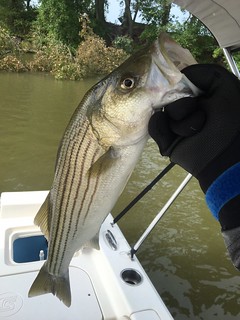
While casting in the lower Choptank River, Herb Floyd managed to catch this nice striped bass. Photo by Herb Floyd
Trolling can be a good option also along the steeper channel edges and some shoal and knoll areas. A mixed spread of small spoons, medium-sized bucktails and surge tube lures (hoses) have been popular. Some are also slow trolling with deep diving crankbaits with good luck.
There are still some spot to be found near Sandy Point State Park and live lining near some of the more popular channel edges has been a very successful venture. Locals will often be seen live lining eels around Pooles Island and the Key Bridge for striped bass.
There are a lot of two-year-old striped bass in the upper bay region and can often be seen chasing bait throughout the region. Anglers fishing topwater lures near the Susquehanna Flats report catching a large percentage of sub-legal striped bass. The Conowingo Dam recently has gone several days without any water releases, causing some low water conditions.
Fishing for white perch has been very good in the tidal rivers. Due to warmer water temperatures they can still be found by casting small lures in relatively shallow areas near shoreline structures. They can also be found on hard bottom in deeper waters where fishing with dropper fly jigs or bait is a good option. Channel catfish are active and can be found in most tidal rivers and there are flathead catfish near the Conowingo Dam pool and the lower Susquehanna.
Water temperatures in the middle bay region are holding around 73 degrees this week and do not show signs of changing anytime soon. The good part is that spot can still be found in the region, so live lining spot is still the most popular way to catch a limit of nice striped bass. Thomas Point, Tolleys, the False Channel and the Diamonds have been popular locations to live line this week.
Small pesky bluefish continue to be part of the mix but as long as plenty of spot are available, they are just something to tolerate. Trolling can also be a good option.
A few Spanish mackerel are being found mixing it up with small bluefish and small striped bass as they chase bay anchovies in the region. This surface action has been a common occurrence along shipping channel edges, near anchored ships and at the mouths of some of the major tidal rivers.
The shallow water fishery for the larger striped bass tends to be off to a very sluggish start in the lower Choptank River but we’re hearing good reports from the Eastern Bay area. Topwater lures tend to be the favorite presentation for this kind of fishing in the early morning and evening hours.
White perch fishing has been good in some of the deeper areas along shorelines and structure areas such as docks and rocks. Small jigs, chartreuse Clouser flies and small beetle spins have been favorite lures to use. Grass shrimp on a simple one-hook bottom rig will work extremely well around structures.
The fishing scene in the lower bay region tends to remain static for several different fisheries this week but change is on the horizon. Stable water temperatures are perhaps the largest reason and a lingering cold front would be the tipping point for change.
Right now live lining for striped bass is the most popular and successful way to put larger rockfish in the boat. The channel edges of Point Lookout and the Cove Point area have two of the better places to fish when live lining spot.
There are a lot of small striped bass measuring under 20 inches in the lower bay region and they can be found chasing schools of bay anchovies in the bay channels with bluefish and Spanish mackerel as sidekicks. Casting to breaking fish is always fun. Jigging deep underneath can pay off at times with larger striped bass and sometimes a large red drum. Anglers are still reporting that large red drum and bluefish are feeding on small sea trout. Trolling can be a good tactic around the outside edges of breaking fish or near slicks that represent recent feeding activity. Small spoons and surge tubes pulled behind planers have been a good tactic as have deep diving crankbaits which have also been catching large red drum.
We’ve seen improvements in fishing topwater lures near shoreline structures, like remnants of the Cedar Point light, as well as prominent points and marsh edges on the eastern side of the bay. Generally this is an early morning and evening show and can also account for some sizable speckled trout and slot-size puppy drum on the eastern side of the bay.
Bottom fishing for a mix of spot, kingfish, white perch, sea trout, speckled trout and northern blowfish continues to provide plenty of fun and good eating this week. This collection tends to accumulate on hard bottom in the Point Lookout to the Point No Point area as well as the Tangier Sound region.
Before we get into the crabbing, freshwater and ocean reports, here is the update and forecast from the team at Click Before You Cast.
Weekly Fishing Conditions Forecast Summary — Oct. 11-18
The variable weather we are experiencing continues this upcoming week and will impact bay water conditions. Main bay temperatures have warmed two degrees since last week and are now back up to about 74 degrees Fahrenheit. Expect windy and rainy conditions from Wednesday through Friday. Sunny, dry and warmer temperatures over weekend will change again to cooler temperature early next week. These cool, windy conditions will continue to help improve water temperature and oxygen conditions and are much more to the liking of hungry rockfish. While most Maryland waters have adequate oxygen from surface to bottom, start your search just above the “Do not fish below this depth.” In the upper bay near Swan Point (along Tolchester channel) and Baltimore Harbor avoid fishing depths below 13 feet. At the Bay Bridge on the west side, fish above 20 feet. On the east side of the bridge, don’t fish below 15 feet. From Bloody Point and into Eastern Bay, suitable oxygen can be found above 23 feet. From the Choptank River south, there is plenty of oxygenated water well below 30 feet and in many places, throughout the entire water column. Expect some reduced water clarity from algal blooms in the Gunpowder, Back and Susquehanna Flats. There will be normal flows for streams and rivers entering Maryland’s portion of the Bay. In addition, there will be excellent tidal currents from Monday through Wednesday as a result of the upcoming new moon on Friday (10/20/17).
For the full weekly fishing conditions summary and more detailed and up-to-date fishing conditions in your area of the bay, be sure to check out Eyes on the Bay’s Click Before You Cast. Since this is a new feature for Chesapeake Bay anglers, drop us a line with comments or suggestions.
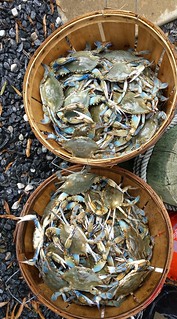
Rich Watts sent in this picture of two bushels he and a friend caught this past weekend in the middle bay region. Photo by Rich Watts
Recreational crabbing continues to provide opportunity for anyone hoping to catch some heavy crabs for at least one more fun crab feast. Generally speaking, despite warm water temperatures and high salinities, catching a decent catch of crabs in the upper bay has been tough. Opportunity abounds in the middle and lower bay regions if you are fortunate to get your baits to where the crabs are. Despite a general onslaught of sooks the most successful crabbers continue to use razor clams for bait. A few tips relayed to me yesterday included that crabbing at 12 feet is good but 15 feet is better, hard bottom can be important and clear water has been causing some crabs to let go as they come up on a trot line.
Cooling water temperatures at Deep Creek Lake are improving fishing for smallmouth bass, yellow perch, walleye, largemouth bass and northern pike this week. Targeting deep grass edges and rocky bottom has been a good tactic with jigs, small crankbaits and live bait.
The upper Potomac River continues to run low and clear so far this week with a lot of loose grass floating in the current. Predicted rains later on this week may raise water levels, but long casts, light line and careful approaches will be in order if they don’t. Targeting grass edges, submerged ledges and current breaks with tubes and topwater lures tends to be a good tactic.
Fishing for crappie has been very good lately in impoundments and tidal waters. Fishing with small jigs and minnows near fallen tree tops, sunken brush and wood as well as marina dock and bridge piers. Crappie are common in many reservoirs and lakes as well as tidal rivers and make for some wonderful eating.
Largemouth bass tend to be in a bit of a transition this week, partially stuck in a summer mode of behavior due to warm water temperatures but stepping into fall as grass beds diminish and water temperatures do cool slightly. Frogs and buzzbaits worked near grass edges continue to be a good tactic this week and when fishing in the tidal rivers such as the Potomac, don’t miss the chance to fish these edges during an ebbing tide. Also fishing tidal waters with noisy topwater lures can help attract northern snakeheads.
Blue catfish are very active in the tidal Potomac this time of the year and it is not hard to catch a mess of medium-sized ones to fill your freezer. Fresh cut bait on a simple bottom rig will do the trick. Blue catfish are rapidly spreading throughout the Chesapeake Bay system and becoming more common.
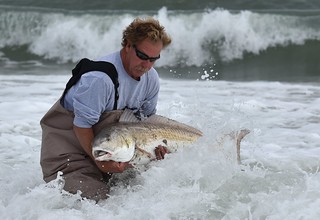
Ron Reuter cradles a beautiful 43-inch red drum before releasing it back into the ocean. Photo by Allen Sklar
The fall trout stocking program is underway and has completed its first full week, giving put and take fishermen a chance to take some trout home. Some of the smaller creeks and streams in the western region are running low so stocking crews may have to adjust stockings. The stockings will be posted as they are completed on the trout stocking website and by the email subscription list.
The Ocean City area had to deal with wind again last weekend but conditions were not so bad that folks couldn’t fish. The surf has calmed down and surfcasters are catching kingfish on bloodworms and bluefish on cut bait or finger mullet. Those casting out heavier baits have been catching inshore sharks and rays as well as catch and releasing a few large red drum.
Inside the inlet and around the south jetty the sheepshead bite continues to be strong and some nice catches are occurring with sand flea and green crab baits. Tautog are starting to show up also and a few keeper-sized samples are being caught at the jetties and Route 50 Bridge area. Flounder are moving through the inlet and some big ones are being caught on large baits. Live spot and mullet are popular live baits to drift in the inlet and puppy drum can be part of the mix, along with sea trout.
The channels leading to the inlet are funneling flounder on their voyage to offshore waters for the winter. The next couple of weeks are perhaps the best flounder fishing of the season as flounder move through these channels. There is also a mix of sea trout and puppy drum being caught at these locations.
Outside the inlet, flounder are holding in some of the shoal areas. They often linger on the inshore shoals, wrecks and reef sites. Tautog are showing up on the inshore wrecks and reefs and keeping anglers busy until the sea bass season opens on October 22.
The boats that are venturing out to the canyons are finding a lot of chicken dolphin holding near lobster pot buoys and a few gaffer dolphin are being caught while trolling along with a few wahoo.
“There are two distinct kinds of visits to tackle-shops, the visit to buy tackle and the visit which may be described as Platonic when, being for some reason unable to fish, we look for an excuse to go in and waste a tackle dealer’s time.” – Arthur Ransome, 1929
 ABOUT THE AUTHOR Keith Lockwood has been writing the Fishing Report since 2003 and has had a long career as a fisheries research biologist since 1973. Over the course of his career he has studied estuarine fishery populations, ocean species, and over a decade long study of bioaccumulation of chemicals in aquatic species in New Jersey. Upon moving to Oxford on the eastern shore of Maryland; research endeavors focused on a variety of catch and release studies as well as other fisheries related research at the Cooperative Oxford Laboratory. Education and outreach to the fishing public has always been an important component to the mission of these studies. Keith is an avid outdoorsman enjoying hunting, fishing, bird dogs, family and life on the eastern shore of Maryland.
ABOUT THE AUTHOR Keith Lockwood has been writing the Fishing Report since 2003 and has had a long career as a fisheries research biologist since 1973. Over the course of his career he has studied estuarine fishery populations, ocean species, and over a decade long study of bioaccumulation of chemicals in aquatic species in New Jersey. Upon moving to Oxford on the eastern shore of Maryland; research endeavors focused on a variety of catch and release studies as well as other fisheries related research at the Cooperative Oxford Laboratory. Education and outreach to the fishing public has always been an important component to the mission of these studies. Keith is an avid outdoorsman enjoying hunting, fishing, bird dogs, family and life on the eastern shore of Maryland.
Want the Weekly Fishing Report sent right to your inbox? Click here to sign up!

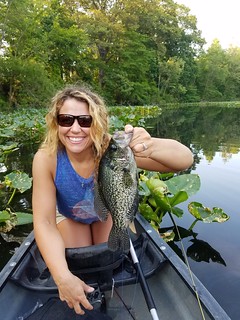
 1-888-373-7888
1-888-373-7888 233733
233733